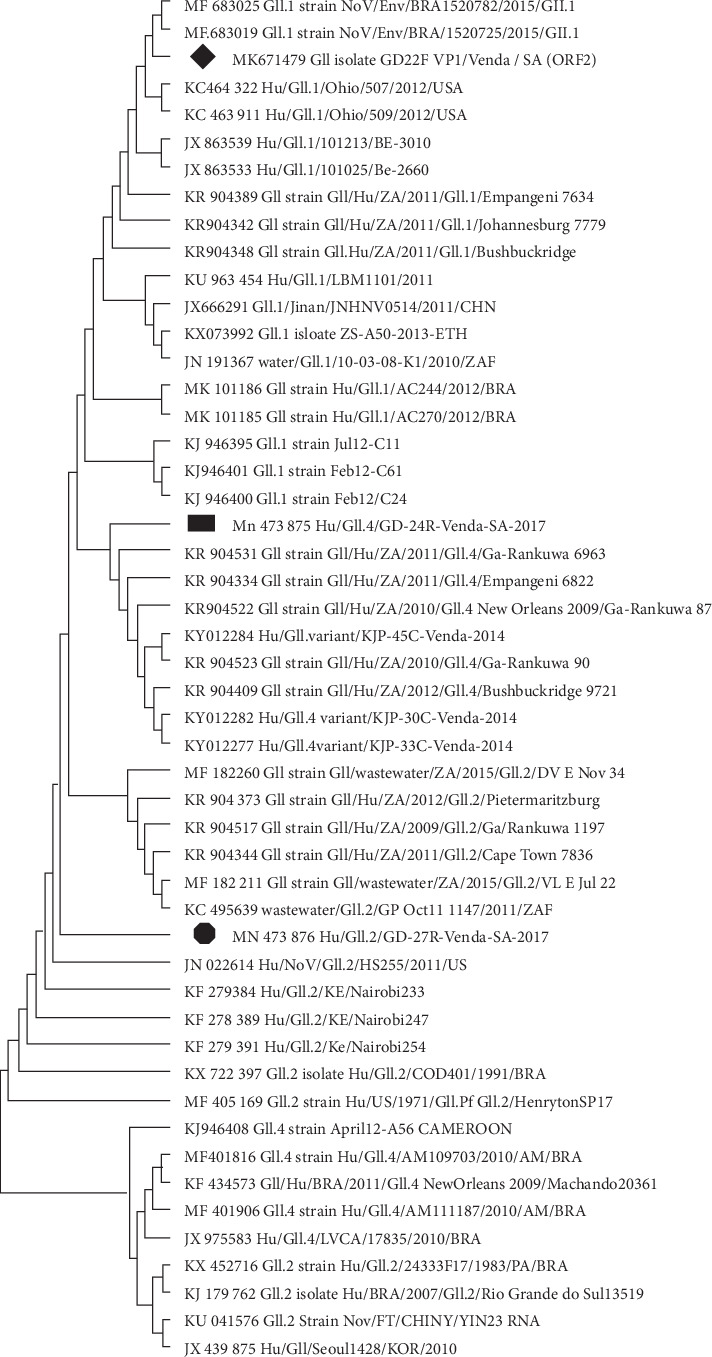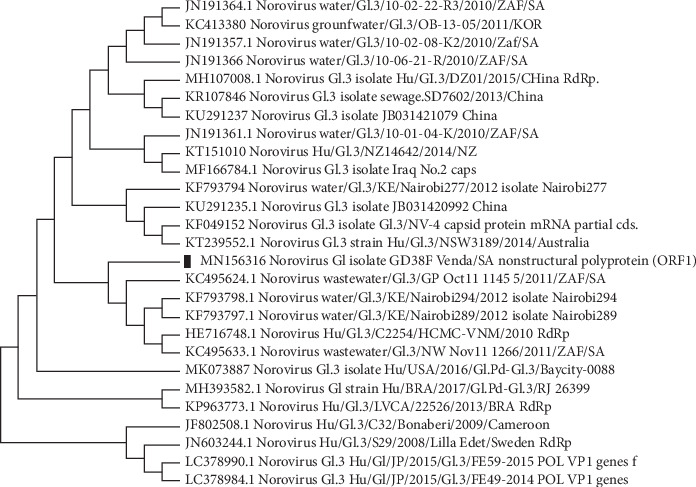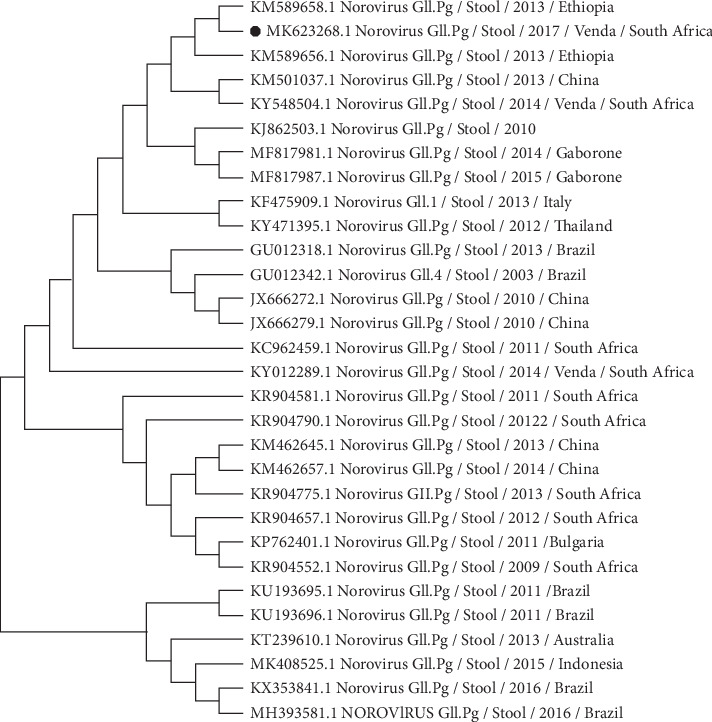Molecular Characterization of Norovirus Strains Isolated from Older Children and Adults in Impoverished Communities of Vhembe District, South Africa.
IF 1.4
Q4 VIROLOGY
G Mulondo, R Khumela, J P Kabue, A N Traore, N Potgieter
下载PDF
{"title":"Molecular Characterization of Norovirus Strains Isolated from Older Children and Adults in Impoverished Communities of Vhembe District, South Africa.","authors":"G Mulondo, R Khumela, J P Kabue, A N Traore, N Potgieter","doi":"10.1155/2020/8436951","DOIUrl":null,"url":null,"abstract":"<p><strong>Background: </strong>Human norovirus (NoV) is an etiological agent associated with acute gastroenteritis (AGE) in both children and adults worldwide. However, very few studies have been reported on the prevalence and genetic diversity of NoV strains in children older than 5 years of age and adults with little or inadequate water and sanitation conditions.</p><p><strong>Objectives: </strong>The aim of this study was assessing the prevalence of the human norovirus in older children and adults suffering with diarrhoea from rural communities in the Vhembe district, Limpopo province.</p><p><strong>Methods: </strong>Between August 2017 and October 2018, stool samples were collected from outpatients suffering from AGE and screened for NoV strains using the RIDA©GENE norovirus I and II real-time one-step RT-PCR. RNA extracts of NoV-positive samples were subjected to RT-PCR amplification and nucleotide sequencing to genotype the positive NoV strains.</p><p><strong>Results: </strong>Out of 80 collected stool samples, 13 (16%) were tested positive for norovirus. Genogroup GII was identified in 6/13 (46%) samples and genogroup GI in 7/13 (54%) samples. The sequence analyses showed multiple genotypes including GII.Pg, GII.1, GII.2, GII.4, and GI.3. Phylogenetic analysis revealed the relatedness of NoV genotypes identified with other strains reported globally.</p><p><strong>Conclusion: </strong>Continued systematic surveillance to evaluate norovirus association with diarrhoea is needed to assist with epidemiological surveillance and disease burden in people of all the age groups.</p>","PeriodicalId":7473,"journal":{"name":"Advances in Virology","volume":"2020 ","pages":"8436951"},"PeriodicalIF":1.4000,"publicationDate":"2020-06-29","publicationTypes":"Journal Article","fieldsOfStudy":null,"isOpenAccess":false,"openAccessPdf":"https://sci-hub-pdf.com/10.1155/2020/8436951","citationCount":"5","resultStr":null,"platform":"Semanticscholar","paperid":null,"PeriodicalName":"Advances in Virology","FirstCategoryId":"1085","ListUrlMain":"https://doi.org/10.1155/2020/8436951","RegionNum":0,"RegionCategory":null,"ArticlePicture":[],"TitleCN":null,"AbstractTextCN":null,"PMCID":null,"EPubDate":"2020/1/1 0:00:00","PubModel":"eCollection","JCR":"Q4","JCRName":"VIROLOGY","Score":null,"Total":0}
引用次数: 5
引用
批量引用
Abstract
Background: Human norovirus (NoV) is an etiological agent associated with acute gastroenteritis (AGE) in both children and adults worldwide. However, very few studies have been reported on the prevalence and genetic diversity of NoV strains in children older than 5 years of age and adults with little or inadequate water and sanitation conditions.
Objectives: The aim of this study was assessing the prevalence of the human norovirus in older children and adults suffering with diarrhoea from rural communities in the Vhembe district, Limpopo province.
Methods: Between August 2017 and October 2018, stool samples were collected from outpatients suffering from AGE and screened for NoV strains using the RIDA©GENE norovirus I and II real-time one-step RT-PCR. RNA extracts of NoV-positive samples were subjected to RT-PCR amplification and nucleotide sequencing to genotype the positive NoV strains.
Results: Out of 80 collected stool samples, 13 (16%) were tested positive for norovirus. Genogroup GII was identified in 6/13 (46%) samples and genogroup GI in 7/13 (54%) samples. The sequence analyses showed multiple genotypes including GII.Pg, GII.1, GII.2, GII.4, and GI.3. Phylogenetic analysis revealed the relatedness of NoV genotypes identified with other strains reported globally.
Conclusion: Continued systematic surveillance to evaluate norovirus association with diarrhoea is needed to assist with epidemiological surveillance and disease burden in people of all the age groups.
南非Vhembe地区贫困社区大龄儿童和成人诺如病毒分离株的分子特征
背景:人诺如病毒(NoV)是一种与全球儿童和成人急性胃肠炎(AGE)相关的病原。然而,关于5岁以上儿童和缺乏水和卫生条件的成年人中NoV菌株的流行率和遗传多样性的研究报道很少。目的:本研究的目的是评估林波波省Vhembe地区农村社区患腹泻的大龄儿童和成人诺瓦克病毒的流行情况。方法:收集2017年8月至2018年10月门诊AGE患者粪便标本,采用RIDA©GENE诺如病毒I型和II型实时一步RT-PCR技术筛选NoV菌株。采用RT-PCR扩增和核苷酸测序的方法对新冠病毒阳性菌株进行基因分型。结果:在收集的80份粪便样本中,有13份(16%)检测出诺如病毒阳性。6/13份(46%)样本中鉴定出GII基因组,7/13份(54%)样本中鉴定出GI基因组。序列分析显示包括GII在内的多个基因型。Pg, GII.1, GII.2, GII.4, gii .3。系统发育分析显示,该病毒基因型与国际上报道的其他菌株具有亲缘性。结论:需要继续进行系统监测,以评估诺如病毒与腹泻的关系,以协助所有年龄组人群的流行病学监测和疾病负担。
本文章由计算机程序翻译,如有差异,请以英文原文为准。




 求助内容:
求助内容: 应助结果提醒方式:
应助结果提醒方式:


